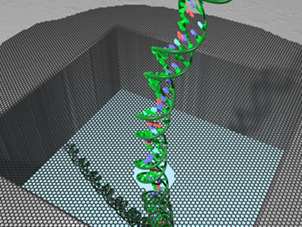Authors: Dimpy Patel and Parthvi Patel
A nanopore is a pore of nanometer size. It may be produced by a pore-forming protein or as a hole in artificial materials such as silicon or graphene. Nanopore is present in an electrically insulating membrane, so it can be used as a single-molecule detector. It can be a natural protein channel in a high electrical resistance lipid bilayer, a pore in a solid-state membrane or a hybrid of these - a protein channel set in a synthetic membrane. The detection principle is based on monitoring the ionic current passing through the nanopore as a voltage is applied across the membrane.
Types of Nanopores
Biological Nanopores
Oxford Nanopores first generation of technology uses personalized, proprietary pore-forming proteins to create pores in membranes. Pore-forming proteins are general in nature. For example, the protein α-hemolysin and similar protein pores are found naturally in cell membranes, where they act as channels for ions or molecules to be transported in and out of cells.

Heptameric protein like α-hemolysin create a pore with an inner diameter of 1 nm, about 100,000 times smaller than that of a human hair. Diameter of the many molecules are same size as a DNA. The pore is highly stable and has been characterized in great detail by Oxford Nanopore .
The identification of single molecule by alteration of protein
Protein nanopores can be adapted at Angstrom-level precision using protein-engineering techniques. Specific adaptations can be designed so that the nanopore is a sensor for a range of specific molecules. Techniques include:
- Altering the architecture of the internal structure of the nanopore so that it affects the route of an analyte through the pore.
- The incorporation of a DNA probe to detect an organism with the similar DNA code.
- The addition of a molecular motor – for example a processive enzyme for the analysis of polymers such as DNA.
- The attachments of ligands or aptamers to the nanopore, to connect with target proteins outside the pore.
Solid-state nanopores
A solid-state nanopore is usually a nanometer-sized hole shaped in a synthetic membrane (usually SiNx or SiO2). The pore is generally fabricated by focused ion or electron beams, so the size of the pore can be tuned liberally, although advance development is necessary to reach the atomic precision naturally achieved by protein pores. Due to the ability of tuning pore geometry, and the superior mechanical and chemical stability of solid-state membranes, substantial R&D work has been performed in this field, including alternative sequencing/diagnostic strategies, new membrane materials, hybrid pores and integrated sensors.
Hybrid pores
Solid-state nanopores presently lack the chemical specificity of protein nanopores. A method under research is the integration of a protein pore into a solid-state membrane.
Nanopores with integrated sensors
Integrated sensors have been explored as technologies to supplant methods involving ionic current measurement. Projected techniques consist of tunnelling electrode-based detectors, capacitive detectors and graphene-based nano-gap or edge state detectors. In recent times, the voltage signal generated by DNA translocation, is proportional to ionic current signal – has been detected experimentally by transistors. This detection scheme may be an attractive alternative to ionic current because it conserves the information of ionic current signal with the potential to achieve much higher integration density and higher speed.
Graphene

Graphene is a strong, single-atom-thick ‘honeycomb’ pattern of carbon with high electrical conductivity. These properties make it an best material for high resolution, nanopore-based sequencing of single DNA molecules. The fine depth of the graphene membrane provides optimal spatial resolution along the DNA, and at the same time, graphene is tremendously strong and chemically inert. Graphene itself is a good electronic feeler material, which is sensitive to nearby molecules and the chemical or electrical environment The graphene nanopore can be used as a trans-electrode, measuring a current flowing via the nanopore between two chambers. The trans electrode was used to measure changes in the current as a single molecule of DNA was passed through the nanopore. This resulted in a characteristic electrical signal that reflected the size and conformation of the DNA molecule. Graphene is supposed to be the thinnest membrane able to separate two liquid compartments from each other. This is an important characteristic for DNA sequencing; a trans electrode of this thickness would be suitable for the accurate analysis of individual bases on a DNA polymer as it passes through the graphene.
Reference
Akeson M, Branton D, Kasianowicz JJ, Brandin E, Deamer DW (December 1999). "Microsecond time-scale discrimination among polycytidylic acid, polyadenylic acid, and polyuridylic acid as homopolymers or as segments within single RNA molecules". Biophys. J. 77 (6): 3227-33. doi:10.1016/S0006-3495(99)77153-5. PMC 1300593 . PMID 10585944
About Author / Additional Info:
M.Sc. Integrated Biotechnology and currently working at Anand Agriculture University